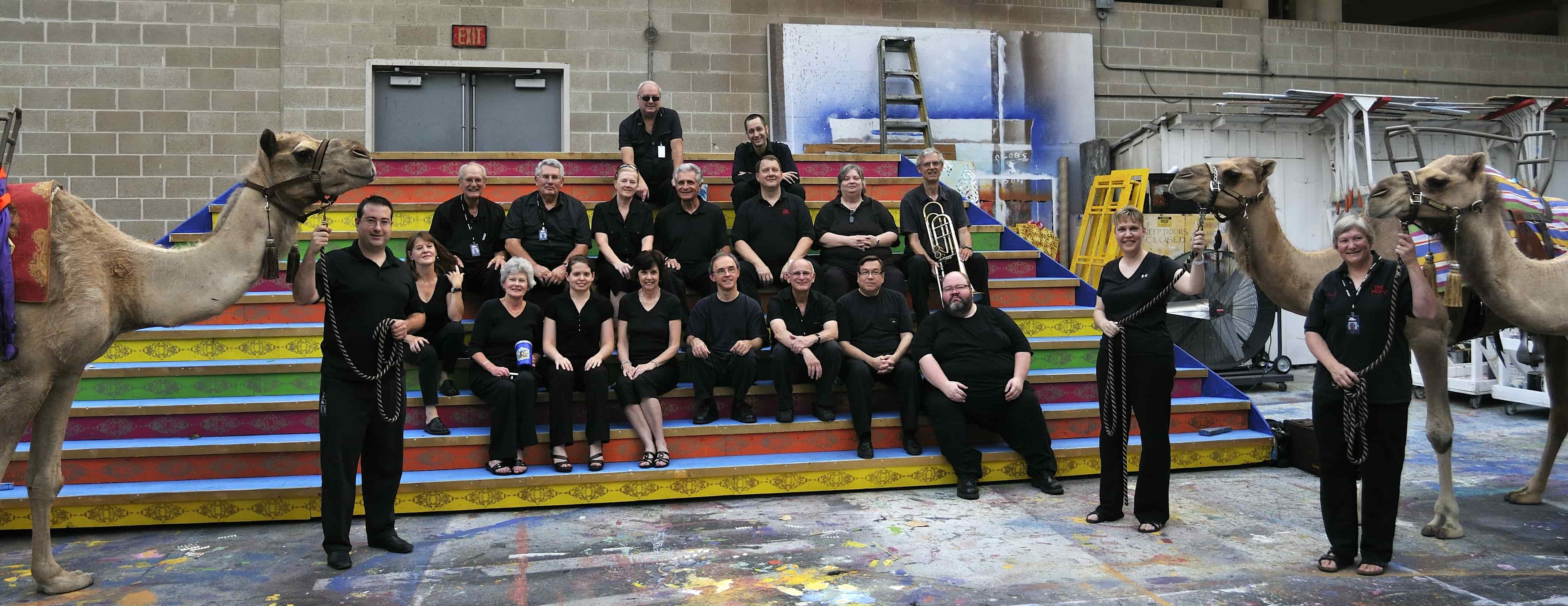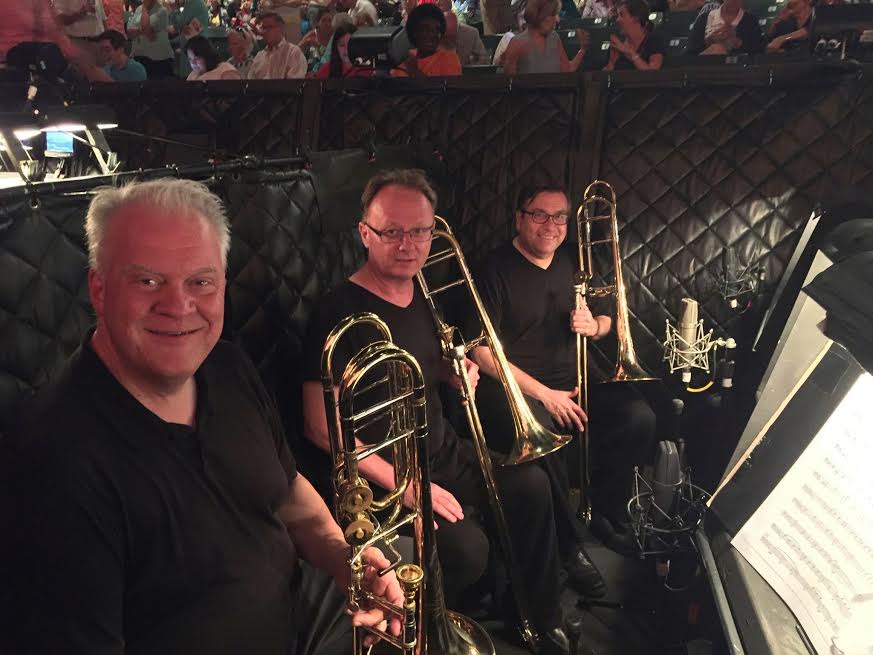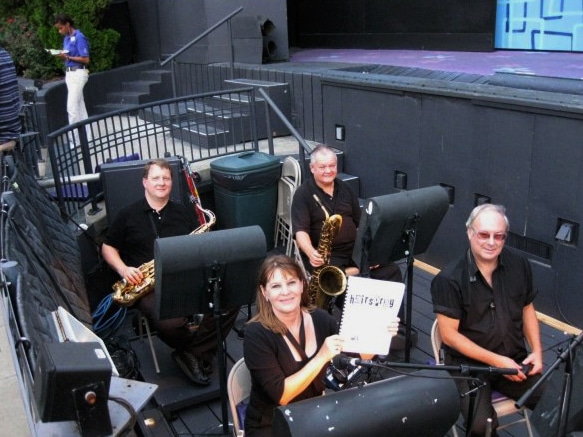Creating 'Muny Magic' in the Orchestra
Most week days, Robert Hughes Jr., Ph.D., focuses on teaching his music students as an associate professor in the Department of Fine and Performing Arts in Xavier Hall, just as Thomas Vincent serves as a manager for Saint Louis University’s advancement systems in DuBourg Hall.
Each reserved and thoughtful, neither man is known at SLU for tooting his own horn. But at the Muny, it’s another matter.
There, both Hughes and Vincent transform into men in black who sound many horns as members of the theater’s renowned orchestra. Vincent serves as principal trombone, but that is not his only instrument.
“I play all the low brass instruments: trombone, bass trombone, euphonium and tuba,” Vincent said. “Rob plays most of the woodwinds.”
“During the course of my time there, I have played piccolo, flute, E-flat clarinet, B-flat clarinet, A clarinet, bass clarinet, soprano, alto, tenor, baritone and bass saxophones,” said Hughes. “This summer is light – I have only played flute, B-flat clarinet, bass clarinet, soprano saxophone and tenor saxophone.”
Well-respected musicians, Hughes and Vincent said they love being Muny performers.
“It is one of the best orchestras around,” notes Hughes.
Muny artistic director and executive producer Mike Isaacson (A&S ‘86, Grad ‘96) offered praise for Hughes, Vincent and their fellow musicians.
“The way I approach it is you know everybody who is here – musicians, stagehands, wardrobe – all of these people here all are artists,” Isaacson said. “Tom and Rob are artists – yes, they have jobs teaching and working [at SLU], but they have an artistic life."
Isaacson recognizes that providing a space where creative people can return each summer knowing they will have a place to express their artistry is critical for them and for the Muny. Each artist helps weave the tapestry of each performance.
“Our mindset is to say ‘Welcome, what is your vision?’” he said. “Everyone here is a trapeze artist flying through the season – catching each other. Everyone is incredibly talented.”
Just how long have Hughes and Vincent been moonlighting at the Muny?
This summer marks 20 years for Hughes and 10 for Vincent – long enough for both men to be tenured performers.
Over the years, both have had their share of adventures in the pit.
“We had two baby raccoons at one point during a rehearsal,” Vincent said. Later that evening, he explained, there was a scream in the audience during the show, followed by an announcement that there would be a brief interruption while “an unwanted visitor was removed from the audience.” “We realized that apparently the mother had come looking for her babies.”
The Unpredictable Outdoors
As an outdoor venue, the theater is sometimes at the mercy of the elements. There are times when it is simply too dangerous or just plain wet to go on.
This year, the final night of “Young Frankenstein” was canceled before it ever began. Weather alerts predicted high winds and rain.
“No one wants to cancel – we want every show to go on,” Hughes said. “And when I say ‘we,’ I mean everyone from the ushers to the stagehands to the actors to the musicians, security, administrators and the rest.”
For Vincent, the fervor and intrepid nature of the Muny’s audiences makes every show worth the wait for a rain delay.
“I admit that I am sometimes surprised by how long they will wait in the rain to see a show,” Vincent said. “It is wonderful.”
For me, it’s the best time of the year. Going to the Muny when it’s hot and when it’s raining – it is an experience.”
Rob Hughes Jr., Ph.D.
Through sun and rain, Hughes and Vincent, clad in classic black shirts and pants, sit at the foot of the Muny’s massive stage. Rehearsals can be long, particularly the final technical run before opening night. Referred to as “sweat tech” for obvious reasons, it lasts three hours the day of the new show’s premiere, ending around 5 p.m.
Then everyone takes an hour or so off before preparing for that evening’s performance, which begins at 8:15 p.m. Typically, the shows run between two and a half to three hours.
“It is quite a long day,” said Vincent, “and it can get hot in the afternoon sun.”
Frequently, the orchestra has a tarp or individual sun umbrellas to shield the musicians. Vincent, like many performers, uses personal fans, as well.
Still, whatever is required, Hughes and Vincent say they enjoy being a part of the iconic theater and its community. And both believe there truly is magic at the Muny.
“For me, it’s the best time of the year – it is the best thing I do all year in terms of performance,” Hughes said. “Going to the Muny when it’s hot and when it’s raining – it is an experience.”
One he would not trade. Hughes notes that there are times when it can feel a bit like camp – it is outdoors and subject to every element, members of the staff are a close circle of workers and performers, and all contribute to the community, he said.
“Many of us have known each other for years,” he said. “We all work together – and I mean everyone. Not just the performers and musicians, but the ushers and back stage crew – every one of us wants to put on a good show every night we can.”
World-Class Productions
Throughout its 98-year history, Forest Park’s premier theater has been run by leaders determined to make events out of its performances. In recent years, this desire to push the envelope has become palpable.
“I have loved the Muny since my first show, ‘Funny Girl,’ in 1997,” said Hughes. “Beginning with that season, I thought that we did better shows every year.”
Hughes attributes the ongoing successes to Isaacson, who has won his share of Tony Awards as a Broadway producer.
“Mike has continued that trend of bigger and better, but the changes are faster and more spectacular,” Hughes said. “He has great instincts and is willing to take chances, most of which are successful.”
From the addition of outdoor fans to innovative creative decisions, Hughes said the leadership of Isaacson and Muny CEO Denny Reagan has been smart and well-spent, helping to grow the Muny’s reputation nationally and internationally.
“Because of his tremendous Broadway success – (How many Tonys does he have?) – Mike has been able to remind the New York theatre world that the Muny is not just typical summer stock – it is the Muny,” Hughes said. “It feels like a new golden age at the Muny, and it is very exciting to be a part of it.”
This year’s season opener, “The Wizard of Oz,” featured an elaborate Emerald City, menacing monkeys in flight and a Great Oz that would make any lion cringe like a kitten.
For “Young Frankenstein,” the sets were massive, as were the special effects – including a scene when “the monster” was raised on a 50-foot forklift.
For the finale of “42nd Street,” the crew built a set of stairs spanning 42 feet – the full length of the stage, complete with 999 lights. Each night before those steps were moved into place, every bulb was checked and rechecked to make sure it would glow.
And every performance showcases the orchestra’s prowess. In this year’s production of “Music Man,” the horn section played a major role, particularly in the finale. Hughes and Vincent were excited to help create the illusion of the boys’ band in grand form when they performed “76 Trombones.”
For this week’s production of “Fiddler on the Roof,” Hughes, Vincent and their fellow musicians in the orchestra are getting a bit of a promotion – literally. Though they will continue to don their classic black attire, they will abandon the pit to play the entire show on stage. The move reinforces the metaphor of community, a theme that is central to the story.
The Muny operates on a grand stage, in a grand setting, but it tempers grand style with equally grand substance.
“Good theater acts as a magnifying glass that reveals a truth,” Isaacson noted. "It provides a lens that allows a singular voice – a solo, a monologue – to speak volumes that often make the most poignant moments on stage.”
Isaacson's respect for artists – along with his own artistry – has enabled the Muny to flourish as the jewel in the crown of theatrical experiences in St. Louis.
“Muny magic has to do with the sum of its parts,” Vincent said. “It really is the case the whole of the experience is so much more – more even than the many, many people committed to putting on a great show. More than the performers and musicians and stagehands and directors. I’m talking about the people in concessions and the ushers, the back lot folks and everyone else. We are all committed to making each performance great.”
Isaacson could not agree more.
“There is no other theater in the world like the Muny. … it’s a real gift to have. Everyone here is so grateful – it is just magic,” he said. “And it’s the music that sprinkles the fairy dust over all of it.”
By Elizabeth Krasnoff Holzer
holzerek@slu.edu


